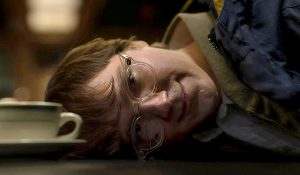
One can judge the quality of a Stephen King adaptation less by the way it handles its monsters and more by the way it approaches the author’s idiosyncrasies. Gary Dauberman, writer and director of the latest version of Salem’s Lot, proves his worth in a single scene.
Eleven-year-old newcomer to small town Jerusalem’s Lot, Mark Petrie (Jordan Preston Carter), tries to wow his recently discovered playground friends by performing a Houdini escape trick. His hands still bound, Mark cannot block an attack by bully Richie Boddin (Declan Lemerande), who stands over the new kid and sneers, “Welcome to the Lot, dillweed.”
With a heroic swell in the soundtrack, Mark returns to his feet. And when Richie charges for another assault, Mark takes the aggressor down and pins his arm back. Despite Richie squealing “Uncle!” Mark keeps the hold until their teacher Mr. Burke (Bill Camp) arrives to break it up. After assuring the kids that he recognizes Richie’s wrongdoing, Mr. Burke imparts one lesson on Mark. “The next time you tell a man to say ‘uncle’ and he does, you let him go,” intones Mr. Burke. “We take people at their word here in the Lot.”
Kid bully? Check. Stylized dialogue? Check. An insular, but changing community? Check. Dauberman nails them all. And we haven’t even gotten to the vampires.
Salem’s Lot follows writer Ben Mears (Lewis Pullman), who returns to the hometown that he left at age nine in hopes of finding inspiration for a novel. As he integrates himself into the community, first by sparking up a romance with small-town/big-dreams girl, Susan (Makenzie Leigh), and then by befriending Mr. Burke and physician Dr. Cody (Alfre Woodard), Mears notices strange happenings. There’s Danny Glick (Nicholas Crovetti), who after his little brother goes missing dies suddenly of a rare disease. Danny’s mother quickly and mysteriously follows both boys into the grave. Meanwhile young man Mike Ryerson (Spencer Treat Clark) gets sick and dies over the course of a day. And crotchety Sheriff Parkins Gillespie (William Sadler) doesn’t want to deal with any of it.
These strange happenings coincide not just with Ben’s arrival, but also that of immigrant Richard Starker (Pilou Asbæk, best known as Euron Greyjoy on Game of Thrones). Starker buys the creepy-looking Marsten House and opens an antiques store with his absent partner Kurt Barlow. Ironically, it is while the town becomes suspicious of newcomer Mears romancing local girl Susie that the real threat, an old-school Nosferatu in Starker’s basement, emerges. And the vampire has a grim vision of what to do to this dying, forgotten town.
That chunky bit of exposition helps explain why the two previous live-action adaptations of King’s novel were TV miniseries, both clocking in at around three hours. Dauberman, by contrast, cuts his movie’s runtime down to under two hours, which he pulls off with a lot of shorthand, helped by its 1970s milieu. The director has been very open about his love of the decade, which most viewers approach with enough distance to accept the story’s less grounded aspects.
That’s particularly true of the thin characterization of all the leads. Pullman never changes his expression of squinting confusion, but that fits Ben, presented here as an observant outsider. Camp and Woodard have no problem going big, and Asbæk has fun playing an ostentatious outsider, but John Benjamin Hickey barely registers as the faithless Father Callahan. The movie’s sole layered performance comes from youngster Jordan Preston Carter. Clear-eyed and no-nonsense, Parker’s Mark could easily embody one of King’s less-successful types, a kid who knows way too much for his age. But Dauberman gives Parker room to be a regular kid, even when he’s marching past Ben with a classmate’s blood on his clothes.
Instead of overburdening the characterizations, Dauberman devotes most of the runtime to gorgeous imagery and well-constructed scares. The horror of Salem’s Lot comes from the arrival of an ancient supernatural force in a small town unprepared to deal with a new highway, much less the undead. Dauberman and cinematographer Michael Burgess contrast the warm nostalgia of the town against the threat in the darkness.
An early attack scene takes place in the woods at dusk, with two boys walking back to their house. A wide tracking shot follows the boys, their bodies mixing with trees in silhouette set against a velvet and turquoise sky. The image would be comforting, were it not for another, larger shadow suddenly lurking behind, engulfing one of the boys and disappearing.
The camera later takes the perspective of that boy from inside a sack as he’s lugged inside the Marsten House to be Barlow’s next meal. A hole in the sack acts as an iris, leaving most of the screen in black and forcing us, like the boy, to watch through a stringy opening. We see the inhuman Barlow descend a staircase and grow ever closer.
Inventive, lovely scare scenes occur throughout the movie. A standout sequence takes place at a drive-in movie where a shadowy line moves closer to our heroes as the sun descends behind the screen. Another occurs in Mark’s bedroom where he scrambles through his toys and magic tricks to find some weapon against the bloodsucker at his window. Even the glowing eyes of the undead recall old flash photography photographs in which the light from the camera gives some viewers an unreal glow.
As effective as Dauberman is at creating a mood and a sense of place, the decision to make Salem’s Lot a period piece does undermine some of the story’s essential power. Part of King’s genius in the 1975 novel was the idea of bringing classical vampires into the modern age. Barlow had all the trademarks of European vampires. He slept in the dirt of his homeland, he had a servant in his thrall, he feared religious symbols. But King forced him to operate in the then modern space of blue collar workers with cars, medicine, and flagging spiritual beliefs.
It’s cool to see a Charger stand in for a coffin during the drive-in sequence in Dauberman’s Salem’s Lot. But viewers in 2024 likely don’t drive gas-guzzlers with their good friends to the watch a movie at the drive-in. They probably stream a movie (on a service such as Max, where Salem’s Lot is debuting, skipping theaters entirely) after working from home and texting friends they never met in person.
Dauberman understands the mood and tone of King’s work. But by keeping it set in the past, the director undermines the full power of even his well-honed scares. Small towns like Jerusalem’s Lot are just as distant today as Transylvania was to viewers in 1931, making Salem’s Lot just another fun horror story about bad things happening far away.
Salem’s Lot streams on Max on Oct. 4, 2024.
The post Salem’s Lot Review: Sumptuous Stephen King Adaptation Drips Nostalgia appeared first on Den of Geek.







